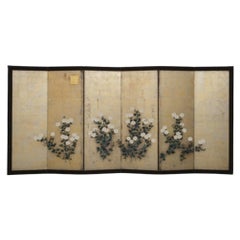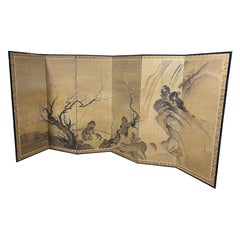Rinpu Sasaki Furniture
to
1
1
1
1
1
1
1
1
1
1
1
1
1
1
1
7,546
3,967
2,548
2,244
Creator: Rinpu Sasaki
Byôbu Screen 屏風 Chrysanthemums, Rinpa School, Edo / Meiji period
By Rinpu Sasaki
Located in Valladolid, ES
One of a kind and very refined Japanese screen or byôbu 屏風 with six folding panels depicting chrysanthemums on a gold background. Fine lacquered wooden frame with metal fittings that protects and supports the work. Dating from the 19th century, between the late Edo period (1603-1868) and the early Meiji period (1868-1912),
The main motif of this beautiful byôbu is a serene Rinpa School painting on a gold background depicting a peaceful flower garden filled with white chrysanthemums. The painting reflects the gentle elegance characteristic of the Rinpa school, known for its refined depiction of nature. In Japanese culture, chrysanthemums symbolize happiness, love, longevity and joy.
Rinpa or Rimpa is the name of one of the most important schools of Japanese painting. It emerged in the 17th century with the artists Honami Kōetsu...
Category
1880s Japanese Edo Antique Rinpu Sasaki Furniture
Materials
Gold Leaf, Silver Leaf
Related Items
Japanese Asian Large Edo Six-Panel Folding Byobu Screen Landscape Monkeys Trees
Located in Studio City, CA
An absolutely gorgeous, wonderfully composed six-panel Japanese Byobu folding screen/room divider depicting a family of playful monkeys among the blooming trees and mountainous lands...
Category
Early 19th Century Japanese Edo Antique Rinpu Sasaki Furniture
Materials
Gold Leaf
H 65.5 in W 140 in D 0.75 in
Japanese Edo Four Panel Screen Flowering White Chrysanthemums
Located in Rio Vista, CA
19th century extraordinary Japanese late Edo/early Meiji period four-panel byobu screen featuring flowering white chrysanthemums painted in a moriage (raised pigment) style. The pain...
Category
19th Century Japanese Edo Antique Rinpu Sasaki Furniture
Materials
Brass, Gold Leaf
Edo Period Rimpa School Golden Screen - Summer Florals
By Rimpa School
Located in Fukuoka, JP
Edo Period Golden Screen - Summer Florals
Period: Edo
Size: 285 x 92.5 cm (112.2 x 36.4 inches)
SKU: PTA141
This Edo period screen is a golden-framed window into the summer gardens...
Category
18th Century Japanese Edo Antique Rinpu Sasaki Furniture
Materials
Gold Leaf
18th Century Japanese Rinpa Screen. White Chrysanthemums. School of Korin.
Located in Kyoto, JP
School of Ogata Korin
White Chrysanthemums
18th Century, Edo period.
A two-panel Japanese screen. Ink, color, gofun and gold leaf on paper.
Dimensions: H. 171 cm x W. 188 cm (67.5” x 74”)
On this two-panel Japanese screen we see blooming chrysanthemums, a flower which embodies the essence of autumn in Japan. Here the traditional floral theme has been simplified and stylized. The bright colors and asymmetrical composition against the delicate gold leaf create a luxurious and ornate work of art. Its background, a strikingly patinated grid of gold leaf, denies any sense of place or time and imbues everything with an ethereal glow. The leaves and stems of the plants are nothing more than pools of mottled color and ink without any outline whatsoever. These are typical Rinpa adaptations of traditional ink painting methods; tarashikomi, or diluted washes of color blended while very wet, and mokkotsu, or “bonelessness,” which creates forms without exterior outlines. The relief work of the rounded flower petals has been obtained by the moriage process (a mixture based on ground shells modeled on the surface of the paper).
On the lower right of the screen, the siganture “Hokyo Korin Jakumyo” and the “Hoshuku” seal can be read. Korin is Ogata Korin, famed for the Irises (Nezu Museum) and Red and White Plum Blossom (MOA Museum of Art) folding screens, both National Treasures. Korin worked in both Kyoto and Edo in the mid-Edo period. Korin was using the art name “Jakumyo” just after he received the Hokyo level, which was in 1701.
This particular screen was published in May of 1961 in the Japanese Sansai Fine Art Magazine*. An in depth article accompanies the photograph of the screen and and a photograph of the signature and seal. This article devotes much of its body to discussing the moriage technique, how it enlivens the chrysanthemum flowers and Korin’s specific skill in using the technique. The article goes on to discuss the most famous works of Korin, utilizing this technique, which were known at the time. Specifically a two-panel screen held in the Honolulu Museum which was discovered in the store-house of Takahashi Soan. A two-panel screen pair which the Nakano family own. A two-panel screen pair with chrysanthemums in moriage in fan designs owned by the Nomura family. Also a small folding screen featuring chrysanthemums held in the Yamato Bunkakan. The article goes on to say that this particular two-fold screen came from the Nijo family. Korin is known to have had a strong connection with the aristocratic Nijo family. The article explains that Korin received a lot of favors from the Nijo family and that this screen would have been gifted to them.
Since that time the Honolulu screen has been amended to ‘attributed to Ogata Korin’ and I do not know further details of the other 3 screens. Other Chrysanthemum screens...
Category
18th Century Japanese Edo Antique Rinpu Sasaki Furniture
Materials
Gold Leaf
H 67.5 in W 74 in D 0.75 in
Japanese Silver Screen Pair, Meiji Period, Herons & Plovers, Shijo School
Located in Kyoto, JP
Heron & Plovers
Ink and silver leaf on paper
Maekawa Bunrei (1837-1917)
A pair of low six-panel Japanese screens by Maekawa Bunrei, a later master of the Kyoto based Shijo school of painting. On the right screen a solitary white heron stands motionless in a stream. On the left screen plovers play along a shoreline. The elegant forms are executed employing fluid, minimalistic ink brushstrokes. The soft brushstrokes and the sharp light of the silver leaf lend the scenes a sense of translucence. The sophisticated composition superbly exploits the long, horizontal pictorial surface of the pair of folding screens...
Category
Early 1900s Japanese Meiji Antique Rinpu Sasaki Furniture
Materials
Silver Leaf
Japanese Edo Four Panel Screen Kano School Filial Piety
Located in Rio Vista, CA
Early 19th century late Edo period Japanese four-panel screen depicting examples from the 24 paragons of filial piety. Painted in the Kano School style featuring figures in colorful,...
Category
19th Century Japanese Edo Antique Rinpu Sasaki Furniture
Materials
Brass, Gold Leaf
Japanese Edo Period Two-Panel Screen
Located in Stamford, CT
A Japanese Edo Period two panel folding screen with white and brown hawks of ink and color on paper.
Category
Mid-19th Century Japanese Edo Antique Rinpu Sasaki Furniture
Materials
Paper
Kiku to Hagi Byobu, Rinpa School Style, Edo Period.
Located in Point Richmond, CA
A Chrysanthemum and Bush Clover painting on gold leaf six-panel folding screen, painted with clusters of leafy green chrysanthemum plants with white blossoms having moriage relief petals of gofun growing amidst pink blossoming bush clover within a bunched bush clover garden fence rendered in lighter gold relief, all on a background entirely of rich gold leaf. These two flowers are symbolic of Japan and the autumn season. The classic patterned paper verso with a Naga Antiques...
Category
Early 1800s Japanese Edo Antique Rinpu Sasaki Furniture
Materials
Gold Leaf
Antique Japanese Meiji Period Silk Embroidered Screen Room Divider Byobu C.1900
Located in London, GB
Antique Japanese Meiji period silk embroidered screen /room divider Byobu C.1900 Kyoto, Japan.
Silk embroidered satin lacquer framed panels....
Category
Early 1900s Japanese Meiji Antique Rinpu Sasaki Furniture
Materials
Silk, Lacquer
H 67.33 in W 88.98 in D 0.79 in
Edo Period Seasonal Transition Screen
Located in Fukuoka, JP
Edo Period Seasonal Transition Screen
Period: Edo
Size: 368 x 153 cm
SKU: PTA148
This exquisite six-panel screen, adorned with golden flakes, beautifully portrays the seamles...
Category
19th Century Japanese Edo Antique Rinpu Sasaki Furniture
Materials
Gold Leaf
Japanese Edo Period Two-Panel Hawks' Screen
Located in Fukuoka, JP
"Hawks' Screen
Period: Edo
Size: 134x152 cm (52.76x59.84 inches)
SKU: SD225
This stunning two-panel screen features depictions of hawks, a subject rich with cultural significance i...
Category
Early 19th Century Japanese Edo Antique Rinpu Sasaki Furniture
Materials
Wood, Paper
Gold Leafed Screen - Late Meiji Period
Located in Fukuoka, JP
Gold Leafed Screen - Late Edo to Meiji Transition
Period: Mid-19th century (Late Edo - Meiji)
Size: 384 x 169 cm
SKU: PN32
Hailing from a pivotal era in Japanese history, this gold...
Category
Early 20th Century Japanese Edo Rinpu Sasaki Furniture
Materials
Gold Leaf
Rinpu Sasaki furniture for sale on 1stDibs.
Rinpu Sasaki furniture are available for sale on 1stDibs. These distinctive items are frequently made of wood and are designed with extraordinary care. There are many options to choose from in our collection of Rinpu Sasaki furniture, although brown editions of this piece are particularly popular. If you’re looking for additional options, many customers also consider furniture by Japanese Studio, and Utagawa Hiroshige (Ando Hiroshige). Prices for Rinpu Sasaki furniture can differ depending upon size, time period and other attributes — on 1stDibs, these items begin at $10,743 and can go as high as $10,743, while a piece like these, on average, fetch $10,743.


